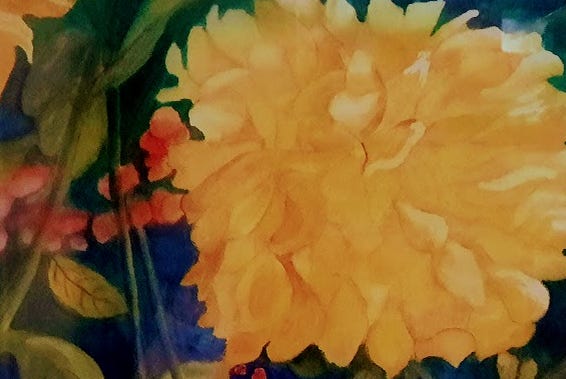If “Beauty is truth, truth, beauty,” as Keats claims, then what do my paintings of flowers, my attempt to capture the truth of those quintessential expressions of beauty mean?
Aldous Huxley in The Perennial Philosophy interprets Keats claim as meaning “Beauty is an immediate experience, and this immediate experience is identical with Beauty-as-Principle, Beauty-as-Primordial-Fact.”
“The experience of beauty in art or in nature,” he continues, “may be qualitatively akin to the immediate, unitive experience of the divine Ground or Godhead; but it is not the same as that experience.”
Still, he asserts that the capacity of the poet or artist to arrange words or paint “in such a way that something of the quality of the graces and inspirations he has received can make itself felt to other human beings in the white spaces, so to speak, between the lines of his verse . . . is a great and precious gift.”
I know my attempt to capture the beauty of flowers is an attempt to capture some inner essence. What is it that I find so captivating, so inspiring, in these delicate, colorful, ephemeral and fleeting creatures? Why do they speak to me in the way they do, and what are they saying?
Words can’t capture it, nor can paint. But sometimes in my quest to capture that inner essence I discover an affinity with it, perhaps in those white spaces of consciousness before brush touches paper. Or in the white spaces of the flower itself where my heart goes to ferret out the petal-deep mystery: how all the curls and swirls and rhythmic symmetry, the lush colors and heady scent come together to draw not only bees and butterflies but artists and poets and nature lovers to worship at its portal, and perhaps unlock the secrets of the universe, the Godhead, and love itself.
Below are a few feeble attempts to capture the ephemeral beauty and fragility of flowers, as well as their lush complexity. Each of these occupy a special place in my home and my heart, a tenderness for the thing I was trying, so inadequately, to grasp. A way to hold on to what cannot be held at all.
“Red Roses in a Blue Vase”, acrylic by Deborah J. Brasket










These are marvelous, Deborah!
Deborah, I'm always reticent to comment because I feel like sometimes I'm on one mountain top and you are on another but yet somehow we still meet in the valley. I think the key word in your piece is "fleeting". The depection of beauty in all art is really a cry about its ephemeral nature and thus, religious. Religion itself is our attempt to out live ourselves, to be more worthy than just our own bodily time and space. But I think Huxley is right, to divorce "beauty" from the human body and assign it as a twin of truth and something that isn't of our worldly domain but something as Shelly would say, we aspire towards, reach towards. But keep painting flowers. I love the sense and completeness in an art that is of one thing, kind. We can find that keatsian beauty / truth in all things - if we look at it long enough.